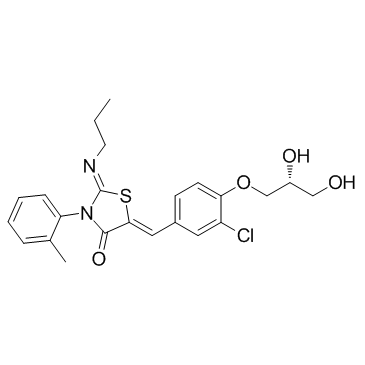
Ponesimod
CAS No. 854107-55-4
Ponesimod( ACT-128800 )
Catalog No. M16202 CAS No. 854107-55-4
A potent, selective, orally active S1P1 receptor agonist with EC50 of 9.1 nM; shows weak activity on S1P3 (EC50=123 nM).
Purity : >98% (HPLC)
 COA
COA
 Datasheet
Datasheet
 HNMR
HNMR
 HPLC
HPLC
 MSDS
MSDS
 Handing Instructions
Handing Instructions
| Size | Price / USD | Stock | Quantity |
| 2MG | 49 | In Stock |


|
| 5MG | 77 | In Stock |


|
| 10MG | 120 | In Stock |


|
| 25MG | 221 | In Stock |


|
| 50MG | 383 | In Stock |


|
| 100MG | 565 | In Stock |


|
| 500MG | 1215 | In Stock |


|
| 1G | Get Quote | In Stock |


|
Biological Information
-
Product NamePonesimod
-
NoteResearch use only, not for human use.
-
Brief DescriptionA potent, selective, orally active S1P1 receptor agonist with EC50 of 9.1 nM; shows weak activity on S1P3 (EC50=123 nM).
-
DescriptionA potent, selective, orally active S1P1 receptor agonist with EC50 of 9.1 nM; shows weak activity on S1P3 (EC50=123 nM); activates S1P1-mediated signal transduction with high potency (EC50 of 5.7 nM); causes maximal reduction of circulating lymphocytes at a dose of 3 mg/kg.Multiple Sclerosis Phase 3 Clinical(In Vitro):Ponesimod activates human S1P1-5 receptors with EC50s of 5.7, >10000, 105, 1108 and 59.1 nM respectively in GTPγS binding assay.Ponesimod activates S1P1 receptors with EC50s of 5.7, 1.9, and 1.4 nM for human, rat, and mouse S1P receptors respectively.(In Vivo):Ponesimod (30 and 175 mg/kg; once daily p.o. for 8 d) prevents delayed-type hypersensitivity in mice.Ponesimod (30 mg/kg by gavage 3 h before and 6 h after adjuvant injection followed by 100 mg/kg/day by administration as food admix for 18 days) prevents adjuvant-induced arthritis in rats.Ponesimod (0.3-100 mg/kg; a single oral gavage) causes a dose-dependent reduction in lymphocyte count, with a plateau effect being reached at 3 mg/kg in rats.Ponesimod (100 mg/kg; once daily oral gavage for 7 d) results in a lymphocyte count reduction to 1900 lymphocytes/μL, and this effect is maintained over the entire 7 days studies. Lymphocyte count returned to baseline levels within 48 h after discontinuation of dosing.
-
In Vitro——
-
In VivoAnimal Model:Female BALB/c mice (15-25 g) sensitized with DNFBDosage:30 and 175 mg/kgAdministration:Gavage (30 mg/kg) 19 and 3 h before sensitization, followed by administration as food admix (175 mg/kg/day) for 8 daysResult:Caused a 60 to 90% reduction of delayed-type hypersensitivity (DTH) parameters of the skin, such as edema, protein extravasation, and neutrophil myeloperoxidase (MPO) activity.Reduced skin levels of proinflammatory cytokines, such as IL-1β, IL-6, IFNγ, TNFα, and several chemokines to different degrees ranging from -27 to -100%.
-
SynonymsACT-128800
-
PathwayGPCR/G Protein
-
TargetLysophospholipid Receptor
-
RecptorS1P1
-
Research AreaInflammation/Immunology
-
IndicationMultiple Sclerosis
Chemical Information
-
CAS Number854107-55-4
-
Formula Weight460.9736
-
Molecular FormulaC23H25ClN2O4S
-
Purity>98% (HPLC)
-
Solubility10 mM in DMSO
-
SMILESO=C1N(C2=CC=CC=C2C)/C(S/C1=C\C3=CC=C(OC[C@H](O)CO)C(Cl)=C3)=N/CCC
-
Chemical Name4-Thiazolidinone, 5-[[3-chloro-4-[(2R)-2,3-dihydroxypropoxy]phenyl]methylene]-3-(2-methylphenyl)-2-(propylimino)-, (2Z,5Z)-
Shipping & Storage Information
-
Storage(-20℃)
-
ShippingWith Ice Pack
-
Stability≥ 2 years
Reference
1. Bolli MH, et al. J Med Chem. 2010 May 27;53(10):4198-211.
2. Piali L, et al. J Pharmacol Exp Ther. 2011 May;337(2):547-56.
3. Sobel K, et al. J Biol Chem. 2013 May 24;288(21):14839-51.
molnova catalog



related products
-
Ozanimod
Ozanimod (RPC-1063)?is a potent, selective agonist of S1P1 and S1P5 receptor with EC50 of 0.41 nM and 11 nM respectively.
-
ASP6432
ASP6432 (ASP-6432) is a potent and selective antagonist of LPA1 receptor, does-dependently inhibits LPA-stimulated increase in intracellular calcium ion with IC50 of 11 nM.
-
Amiselimod hydrochlo...
A novel prodrug S1P receptor modulator lacking S1P3 receptor agonism to avoid bradycardia associated with fingolimod and other S1P receptor modulators.



 Cart
Cart
 sales@molnova.com
sales@molnova.com


